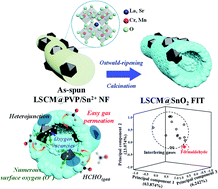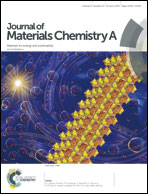Perovskite La0.75Sr0.25Cr0.5Mn0.5O3−δ sensitized SnO2 fiber-in-tube scaffold: highly selective and sensitive formaldehyde sensing†
Abstract
In this work, highly porous SnO2 fiber-in-tubes (FITs), which are functionalized with perovskite La0.75Sr0.25Cr0.5Mn0.5O3−δ (LSCM) particles as a chemical sensitizer, are used as a superior formaldehyde (CH2O) sensing layer. LSCM-loaded as-spun Sn precursor/polymer composite fibers are rapidly calcined to create a porous FIT SnO2 structure with high surface area. Such unique morphological evolution originates from the Ostwald ripening effect and crystal growth inhibition caused by LSCM particles. Furthermore, LSCM particles with high oxygen vacancy concentration and a large work function significantly promote oxygen spillover and electron depletion on the surface of SnO2 (6.80 eV for LSCM vs. 4.55 eV for SnO2). As a result, LSCM-loaded SnO2 FITs (LSCM@SnO2 FITs) provide remarkably high response to formaldehyde (Rair/Rgas = 26.50 to 5 ppm) and excellent selectivity against interfering gases (H2S, C7H8, NH3, C2H6O, C8H10, CO, and C5H12) even without using noble metal catalysts. These observations demonstrate the potential use of LSCM@SnO2 FITs for real-time monitoring of indoor air quality, especially toward formaldehyde, which has not been accurately detected by using conventional metal oxide based sensors.



 Please wait while we load your content...
Please wait while we load your content...